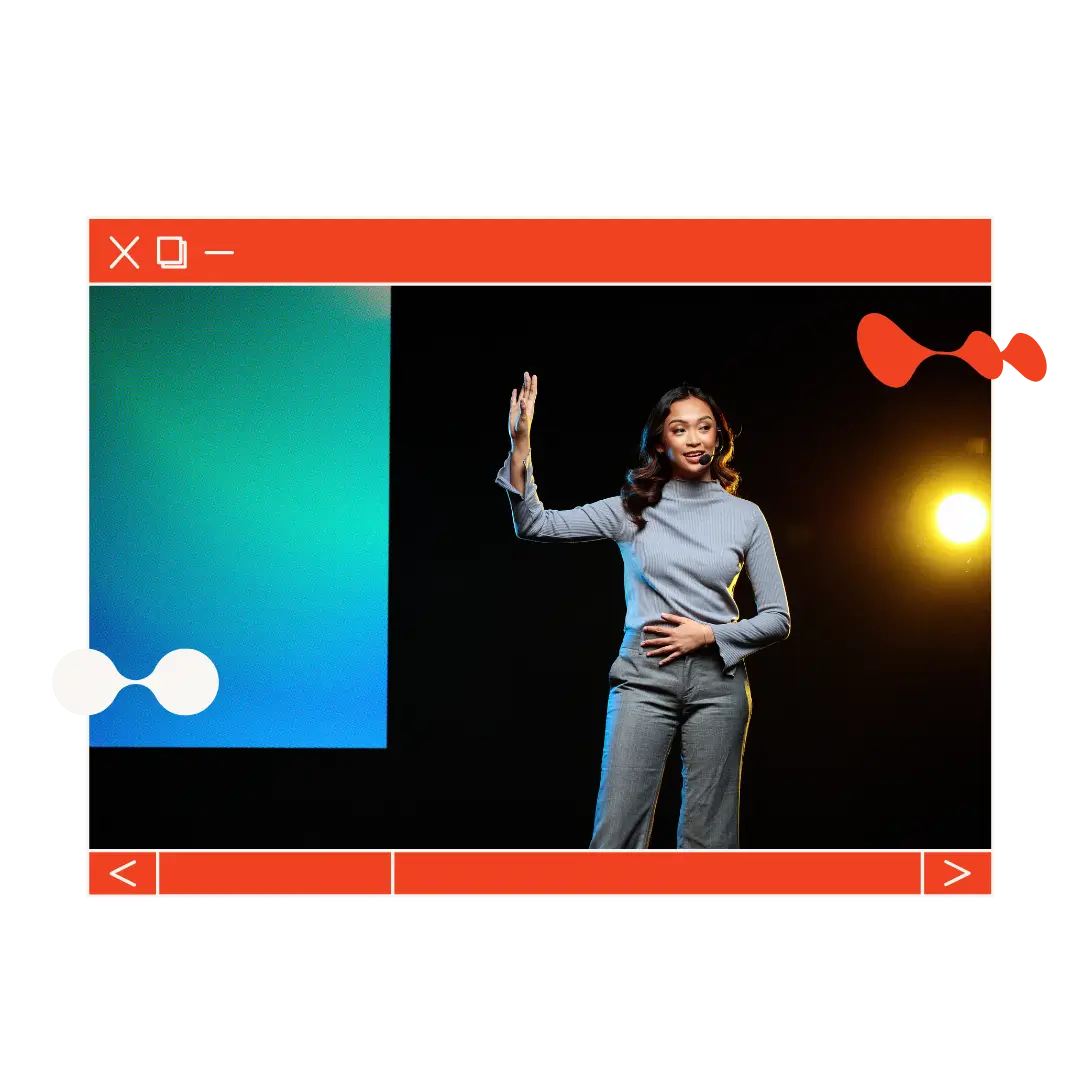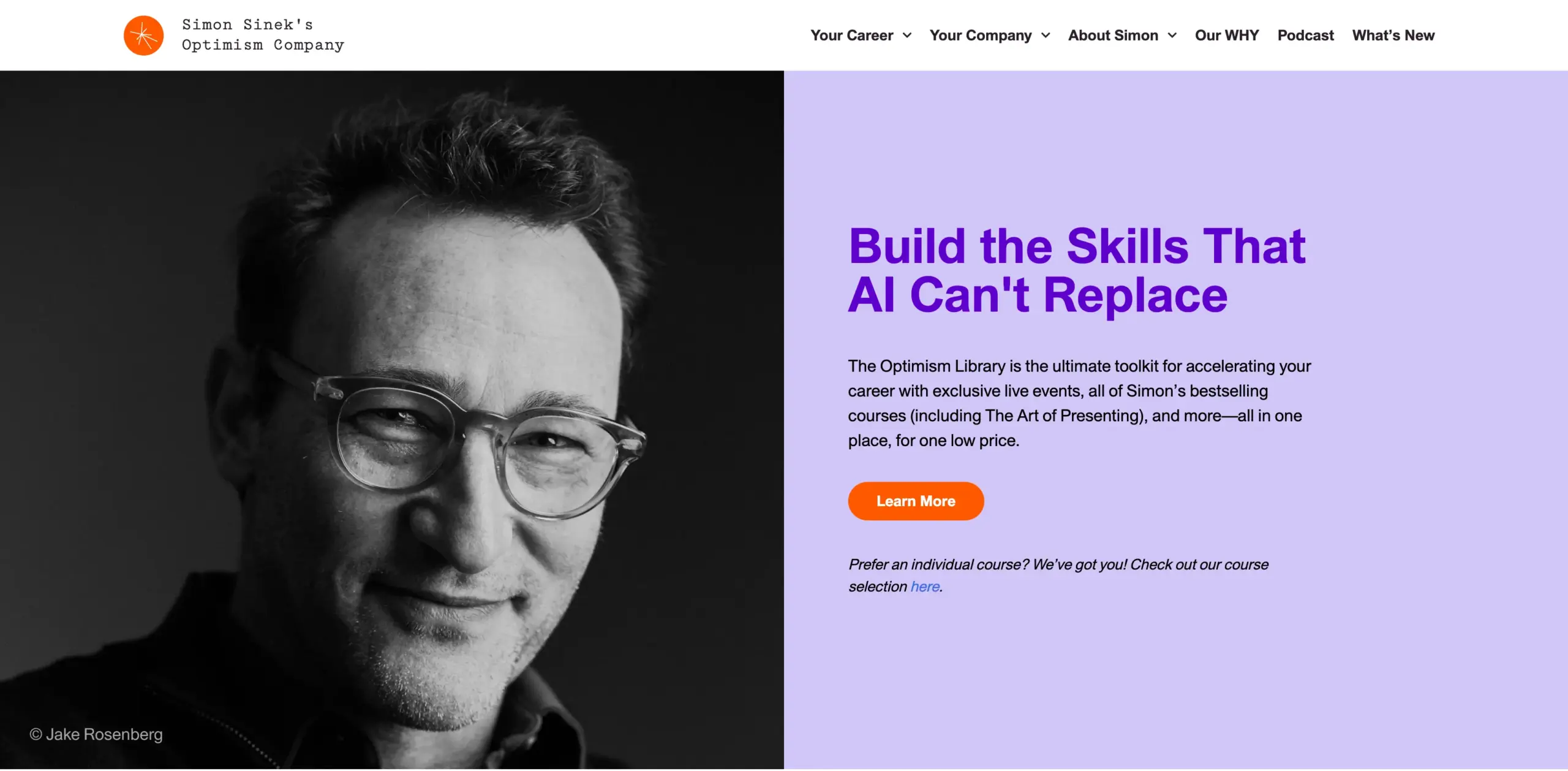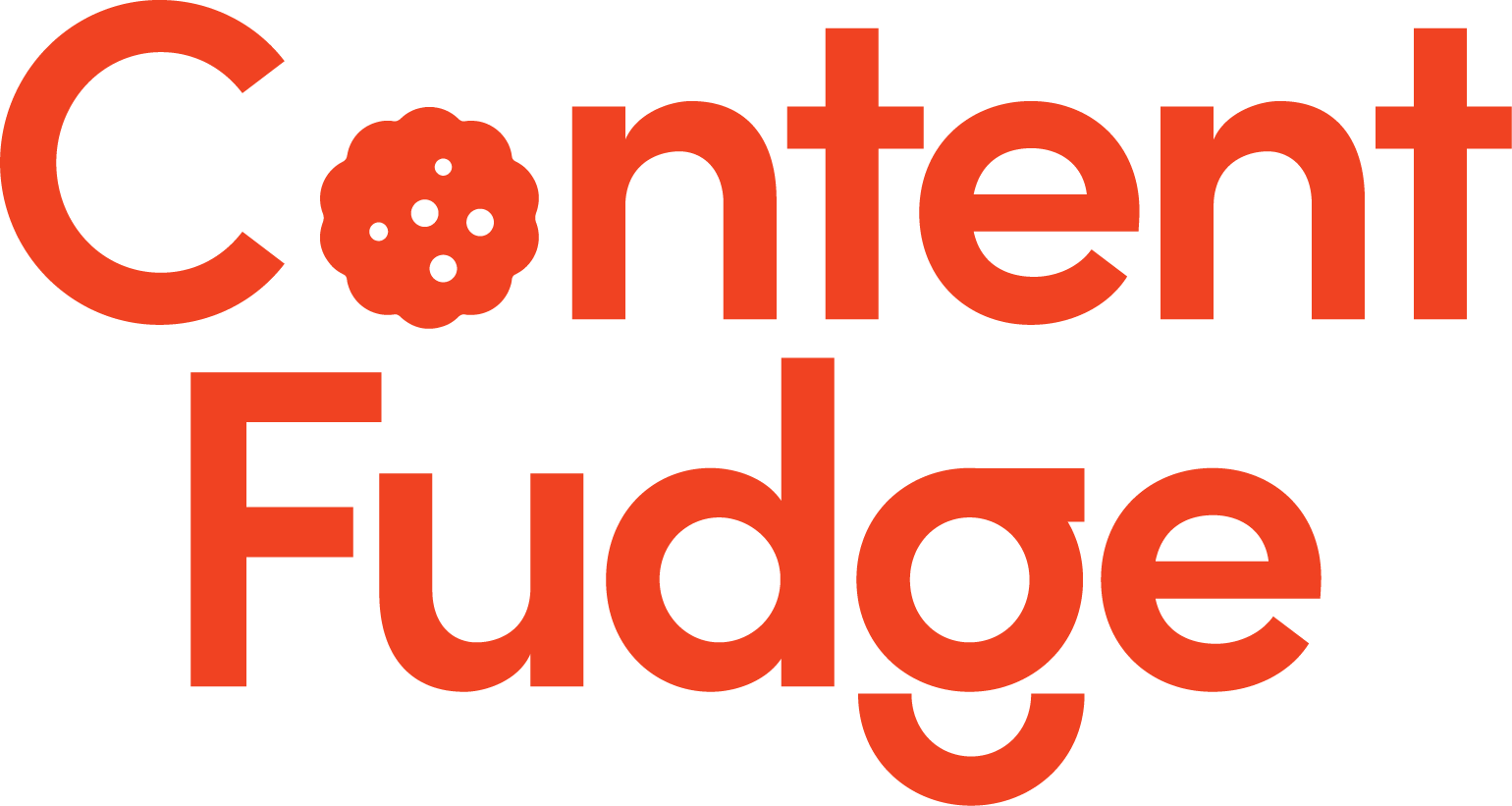Building a Powerful Online Presence as a Keynote Speaker
Written by Anzhelika Tauber

Key differences in online branding for keynote speakers vs. other personal brands
Keynote speakers have unique branding needs. Unlike a “normal” personal brand or influencer profile, a speaker’s online presence must lead with authority and cater to event planners seeking trustworthy experts for their audiences.
Here are some characteristics that distinguish a speaker’s branding online:
Authority first, personality second:
Speakers must establish credibility immediately. Your site should scream your expertise and authority in your field – through headlines, credentials, and even design.
For example, Simon Sinek’s website immediately reinforces his thought leadership in optimism and leadership with a clean, professional design and bold statements of his vision:

Event planners often decide within deconds if you seem credible; in fact, visitors form an opinion of a website in just 50 milliseconds (Speakerflow)!
Use that split-second wisely to project authority. This might mean prominently displaying “As seen in” media logos, listing marquee clients, or showcasing any titles (Ph.D., bestselling author, etc.) right at the top.
The goal is to immediately answer “Why you?” with visuals and text that convey “I’m a leader in this space.”
Media readiness and press-friendly content:
Unlike typical personal brands, keynote speakers should be media-ready. This means having a press kit or speaker kit available and keeping your messaging consistent for interviews, press releases, and event marketing.
Brené Brown’s speaking page, for instance, doesn’t just tell her story – it directs organizers to coordinate with her speaking bureau and likely provides ready-to-use bios and photos.
Ensure you have a downloadable media kit (PDF) that includes your bio, topic summaries, headshots, introduction script, AV requirements, and contact info. High-profile speakers often work with bureaus, so their sites facilitate that: e.g., “All speaking requests are handled by XYZ Agency” (as seen on Brené’s site).
Even if you’re independent, act like your own publicist – make it easy for media or event planners to get what they need without delay.
Clear bookable offers:
A speaker’s site isn’t just about you – it’s about what you can do for event planners. Unlike a blogger’s site that might sell merchandise or an entrepreneur promoting a product, your “products” are your talks and appearances. Make it straightforward for someone to book you or inquire.
Strong Calls to Action (CTAs) like “Book [Your Name] for Your Event” or “Check Speaking Availability” should feature prominently and repeatedly. In fact, conversion experts note that repeating a CTA multiple times on a page can significantly boost response – one study saw a 20% increase in conversion rate by doing so Khalid Saleh, Invesp).
For instance, Clemens Doppler has a “Book a free call” item on his homepage navigation, and Eric Thomas (“ET the Hip Hop Preacher”) has a “Book ET to Speak” menu item on his homepage navigation ensuring anyone can quickly start the booking process.
Whether your CTA leads to a booking form, your agent’s email, or a scheduling link, make it impossible to miss.
Polished visual identity:
Keynote speakers need a high-end, cohesive visual brand.
Event organizers equate the polish of your website with the quality of your professionalism. Use consistent colors, typography, and imagery that reflect your persona.
Are you a cutting-edge tech speaker? Then a sleek, modern aesthetic fits. A motivational speaker on personal growth might use warm, vibrant visuals.
High-quality photography is non-negotiable – use professional headshots and, even better, action shots of you on stage.
“Nowadays, people read less and focus more on imagery,” notes the Mic Drop Workshop team, emphasizing that a powerful on-stage photo can instantly convey your experience.
Top speakers invest in great photos: think of Simon Sinek’s signature gentle-yet-confident headshot or Tony Robbins’ energetic stage snapshots on his site. These images aren’t just filler; they establish instant credibility (“this person speaks on big stages”) and help visitors visualize you at their event.
Thought leadership content:
To lead in your niche, you must also show you’re actively contributing ideas.
Many keynote speakers maintain content streams – blogs, podcasts, video channels, or books – that reinforce their expertise. This content isn’t just for fans; it’s part of your brand for decision-makers.
A regularly updated blog with insights on your topic (e.g., leadership trends or wellness tips) demonstrates that you’re continuously engaged with your subject matter.
Simon Sinek, for example, extends his brand through a popular podcast and articles, all linked to his site, underscoring his authority in leadership thinking. Such content can set you apart from a speaker who just has a static bio. It’s proof that you have depth, not just a canned talk.
If you have published books or TED talks, feature them prominently – they act as thought leadership assets and credibility markers (and often these are what prospective clients already know you for).
Want more articles like this directly in your mailbox?
Sign up for my newsletter and don’t miss any new insights on social media, online marketing, and brand communication.
Cross-channel consistency:
Keynote speakers often have to maintain a presence on LinkedIn, Twitter (X), YouTube, Instagram, podcast and a newsletter – but the key is presenting a unified brand message across all channels. Your core message, tagline, and visual style should be recognizable whether someone lands on your Twitter profile or your website homepage.
Consistency builds trust.
For example, Brené Brown’s emphasis on authenticity and courage is apparent on her website, social media bios, and even the design of her content; it’s all her.
Similarly, Eric Thomas’s brand is tightly integrated – his site, YouTube channel, and social media all feature the same motivational catchphrase (“When you want to succeed as bad as you want to breathe…”) and his energetic persona. This cohesion means that no matter how an event planner researches you – via Google, LinkedIn, or your site – they get the same impression.
It also means linking these channels: embed your social feeds or latest videos on your site, and ensure your social profiles point back to your website. A cohesive cross-channel presence signals that you are professional and attentive to your brand, which gives organizers confidence in working with you.
Event-focused messaging:
A subtle but important nuance – while a typical personal brand might speak directly to consumers or fans, a keynote speaker’s site should primarily speak to event planners and corporate clients.
Your tone can still be personal and authentic, but the content should address their needs:
- What value does your talk bring to their audience?
- How does hiring you make their event better?
As SpeakerFlow advises new speakers, “the audience for your website is usually not the same as the audience for your talk… your speaker website is fundamentally a tool for getting paid speaking gigs”.
Focus on outcomes and takeaways. For instance, instead of just “I speak on cybersecurity,” frame it as “Cybersecurity Keynote – Helping Financial Executives Protect Data in a Digital World (your audience will learn X, Y, Z)”. By orienting content toward benefits to the audience and event, you show planners you understand their perspective.
This is something meeting planners actively look for: speakers who focus on attendee value, not just self-promotion.
Every description on your site – from your bio to your talk summaries – should answer the planner’s unspoken question: “How will this person make my event a success?”.
Social proof and testimonials:
Trust is currency.
While any professional might have testimonials, for speakers it’s crucial to have the right kind of testimonials – those from event organizers or industry leaders who can attest to your impact on stage and behind the scenes.
A typical personal brand might show customer or client testimonials; you need to show event success stories. Highlight comments from conference organizers about how you engaged the crowd and were a joy to work with, or from CEOs about the actionable insights you delivered.
Also include logos of notable companies or conferences where you’ve spoken (visual credibility boosters). Past client logos on your site are “a quick and easy credibility boost” because visitors will recognize big names and subconsciously trust you more.
Speakers like Eric Thomas list Fortune 500 clients he’s worked with (e.g., Nike, AT&T, UPS) right in his bio and many speaker sites have a carousel of client logos on the homepage.
Additionally, consider adding short video testimonials from organizers or audience members – a 30-second clip of an event planner praising your keynote can be pure gold for convincing the next one.
Interactive and engaging features:
Top speaker websites increasingly incorporate interactive elements to engage visitors and showcase speaking prowess. This goes beyond text and images.
For example, embedded videos (or even a background video) of you speaking can immediately grab attention – given that 63% of event marketers use video to promote events, you can bet planners love seeing video of a prospective speaker.
Some speakers include a highlight reel on the landing section that auto-plays (muted) to instantly convey energy.
Others, like Clemens Doppler, might use interactive sliders or carousels: e.g., a carousel of speech topics or a sliding gallery of photos from various events.
You can also provide interactive content like a downloadable quiz or toolkit that ties into your expertise – doubling as a lead magnet to capture email addresses of potential leads (this is how you blend being helpful to audiences with marketing to planners).
As an example, leadership speaker Brittany Hodak’s site provides a “Meeting Planners” page full of resources and even a lead capture for a superfan engagement workbook.
Think about elements that make your site feel modern and dynamic – a chatbot that answers FAQs about your speaking (even if it just says “Hi, ask me about Josh’s keynote topics!”), or a virtual demo (VR/360 video of you on stage for an immersive touch) if you want to get cutting-edge.
While these aren’t required, they can differentiate you in a sea of static sites.
A keynote speaker’s online brand must strike a balance: it should exude professionalism and authority while still feeling personal and authentic. It’s a taller order than a typical personal website, but it’s achievable by focusing on the right elements.
Remember, meeting planners want to be confident in their choice. Your online presence can either instill that confidence or sow doubt. Invest the time (and if needed, budget) to get it right.
As the saying goes, you never get a second chance to make a first impression – and often your first impression on a client will be your website or LinkedIn, not you in person. By applying these insights, you’ll not only attract more inquiries but also set the stage to command higher fees (because your value is evident) and create a platform for all your other endeavors (books, courses, etc.). Whether you’re a rising speaker or a seasoned pro, take a page from the top-tier speakers: treat your online presence as seriously as your on-stage performance.
Doing so will ensure that when you show up to give that keynote, the audience is full – and they already have high expectations because your brand got them excited to hear you.
Get Sunday Fudge straight to your inbox.
Real social media and marketing, brand communication insights, and personal failures 🙆♂️

Need to optimise your online presence?
Book a free call with me! We will look at your status quo and decide what you need to do next.
